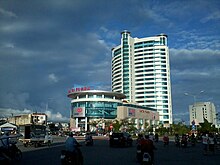Lavana: Difference between revisions
(→Cities) |
No edit summary |
||
| Line 63: | Line 63: | ||
== History == | == History == | ||
=== Pre-history === | === Pre-history === | ||
Lavanan pre-history can trace itself to early human settlement along the various rivers of the region, agriculture can be traced to it's discovery in [[Dezevau]]. Early societies existed on the banks of waterways growing rice and growing minor livestock, they utilized the waterways to transport goods and conduct trade, waterways became very important to the Lavanans and became the basis for [[Lavanan Mythology]], this settlements eventually grew into city-state like entities which controlled sections of rivers and facilitated security and trade between merchants. | |||
=== Early Kungian Period (5th Century B.C.E-1st Century C.E.) === | === Early Kungian Period (5th Century B.C.E-1st Century C.E.) === | ||
[[File:Bronze collections.jpg|thumb|right|Bronze Sasuanan artifacts]] | |||
The first organized entity in the region was that of the Sasuana empire in the early 6th century B.C.E., the Sasuanan Empire rose from the city of Thy Lucc near modern day [[Kurei]] in the river Kung. Thy Lucc was located in a strategic position forcing all trade through the river necessary to cross the cities boundaries, the growth of the Sasuanan's cemented Thy Lucc's importance which would be unrivaled for several centuries. The Sasuana's developed large water projects which increased the yield of rice crops in the region leading to a population boom, the Sasuana's were also able to support the growing trading in the '''Yet to be named sea''', which led to large growth in the cities of the coast which became incredibly wealthy. With the rise of the Sasuana's the position of '''Sao''' was established. | |||
During this time the Lavanan Mythology was in it's period of growth and had established itself as the national religion of the Empire. The empire began to suffer under the stress of growing competition of inland and coastal cities, which sought closer ties with outside entities crucial to bring in wealth, a succession of emperors in the 1st century B.C.E. culminated in the Sao Nan Lap's decision to outlaw foreign influences in coastal cities which culminated in large scale riots by the now bankrupted wealthy merchant class, this weakened Sasuanan power which saw itself threatened by '''Steppe raiders'''. In 105 C.E. the Sasuanan empire would end with the ascension of a steppe Sao in Thy Lucc. | |||
=== Middle Kungian Period (1st Century C.E.-7th Century C.E.)=== | === Middle Kungian Period (1st Century C.E.-7th Century C.E.)=== | ||
=== Classical Kungian Period (7th Century-12th Century) === | === Classical Kungian Period (7th Century-12th Century) === | ||
Revision as of 07:25, 19 July 2020
This article is incomplete because it is pending further input from participants, or it is a work-in-progress by one author. Please comment on this article's talk page to share your input, comments and questions. Note: To contribute to this article, you may need to seek help from the author(s) of this page. |
People's Republic of Lavana ສາທາລະນະລັດປະຊາຊົນລັດ ລະຫວ່າແ | |
|---|---|
|
Flag | |
| Motto: "ຈາກແມ່ນ້ ຳ ທີ່ຍິ່ງໃຫຍ່" "From the Mighty Rivers" | |
| Anthem: "The Thunder and Sky" | |
| Capital and largest city | Pers |
| Recognised national languages | Lavanan, Ziba |
| Ethnic groups | Pasamnoan 78%
Dezevauni 9% Others 9% |
| Religion | Badi 60% Irreligion 20% |
| Demonym(s) | Lavanan |
| Government | Council Republic |
• Premier | Laina Keomany |
• Vice-Premier | Trang Dong |
| Legislature | Lavanan Council |
| Establishment | |
• Formation of the Kingdom of Lavana | 1876 |
• Establishment of the Republic of Lavana | 1943 |
• Establishment of the People's Republic of Lavana | 1964 |
| Population | |
• 2020 census | 49,842,742 |
| GDP (nominal) | 2020 estimate |
• Per capita | 7,373.00 |
| Currency | Lavanan Dunan (LZ) |
| Date format | dd-mm-yyyy |
| Driving side | right |
| Internet TLD | .lv |
Lavana (Lavanan:ລະຫວ່າແ) officially the People's Republic of Lavana (Lavanan:ສາທາລະນະລັດປະຊາຊົນລັດ ລະຫວ່າແ) is a sovereign state in Coius. It borders Dezevau to the north, the yet to be renamed sea to the east, and tbd. With a total area of X, and population of 49,842,742 million people. It's capital is the city of Pers.
Etymology
History
Pre-history
Lavanan pre-history can trace itself to early human settlement along the various rivers of the region, agriculture can be traced to it's discovery in Dezevau. Early societies existed on the banks of waterways growing rice and growing minor livestock, they utilized the waterways to transport goods and conduct trade, waterways became very important to the Lavanans and became the basis for Lavanan Mythology, this settlements eventually grew into city-state like entities which controlled sections of rivers and facilitated security and trade between merchants.
Early Kungian Period (5th Century B.C.E-1st Century C.E.)
The first organized entity in the region was that of the Sasuana empire in the early 6th century B.C.E., the Sasuanan Empire rose from the city of Thy Lucc near modern day Kurei in the river Kung. Thy Lucc was located in a strategic position forcing all trade through the river necessary to cross the cities boundaries, the growth of the Sasuanan's cemented Thy Lucc's importance which would be unrivaled for several centuries. The Sasuana's developed large water projects which increased the yield of rice crops in the region leading to a population boom, the Sasuana's were also able to support the growing trading in the Yet to be named sea, which led to large growth in the cities of the coast which became incredibly wealthy. With the rise of the Sasuana's the position of Sao was established.
During this time the Lavanan Mythology was in it's period of growth and had established itself as the national religion of the Empire. The empire began to suffer under the stress of growing competition of inland and coastal cities, which sought closer ties with outside entities crucial to bring in wealth, a succession of emperors in the 1st century B.C.E. culminated in the Sao Nan Lap's decision to outlaw foreign influences in coastal cities which culminated in large scale riots by the now bankrupted wealthy merchant class, this weakened Sasuanan power which saw itself threatened by Steppe raiders. In 105 C.E. the Sasuanan empire would end with the ascension of a steppe Sao in Thy Lucc.
Middle Kungian Period (1st Century C.E.-7th Century C.E.)
Classical Kungian Period (7th Century-12th Century)
Late Kungian Period (12th Century-14th Century
The Aguda Empire
Colonial Period
Great War
First Civil War
Second Civil War
Steppe Insurgency
Modern times
Geography
Hydrology
Fauna
Flora
Government
Political Divisions
Military
Foreign Relations
Demographics
Health
Education
Religion
Language
Cities
| Largest urban centers by population | |||||||
|---|---|---|---|---|---|---|---|
| # | Settlement | Population | |||||
| 1 | Pers | 5,122,521 | |||||
| 2 | Kurei | 3,951,125 | |||||
| 3 | Kipchu | 2,869,377 | |||||
| 4 | Liucpa | 2,663,356 | |||||
| 5 | Laitaka | 1,662,753 | |||||
| 6 | Yars | 1,133,152 | |||||
| 7 | Sureli | 700,633 | |||||
| 6 | Ongoya | 673,842 | |||||
| 9 | Edrona | 551,853 | |||||
| 10 | Zaola | 313,631 | |||||





